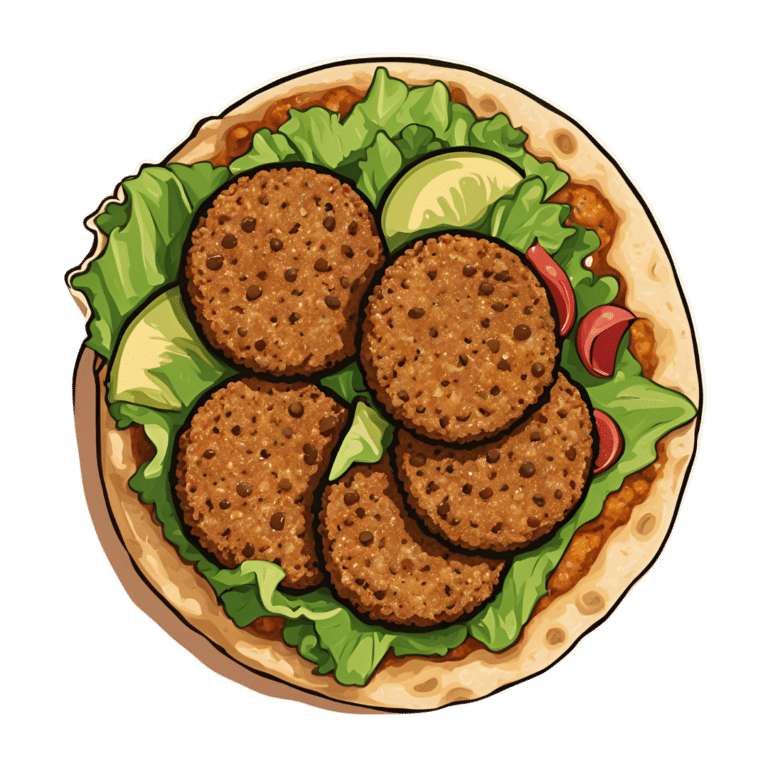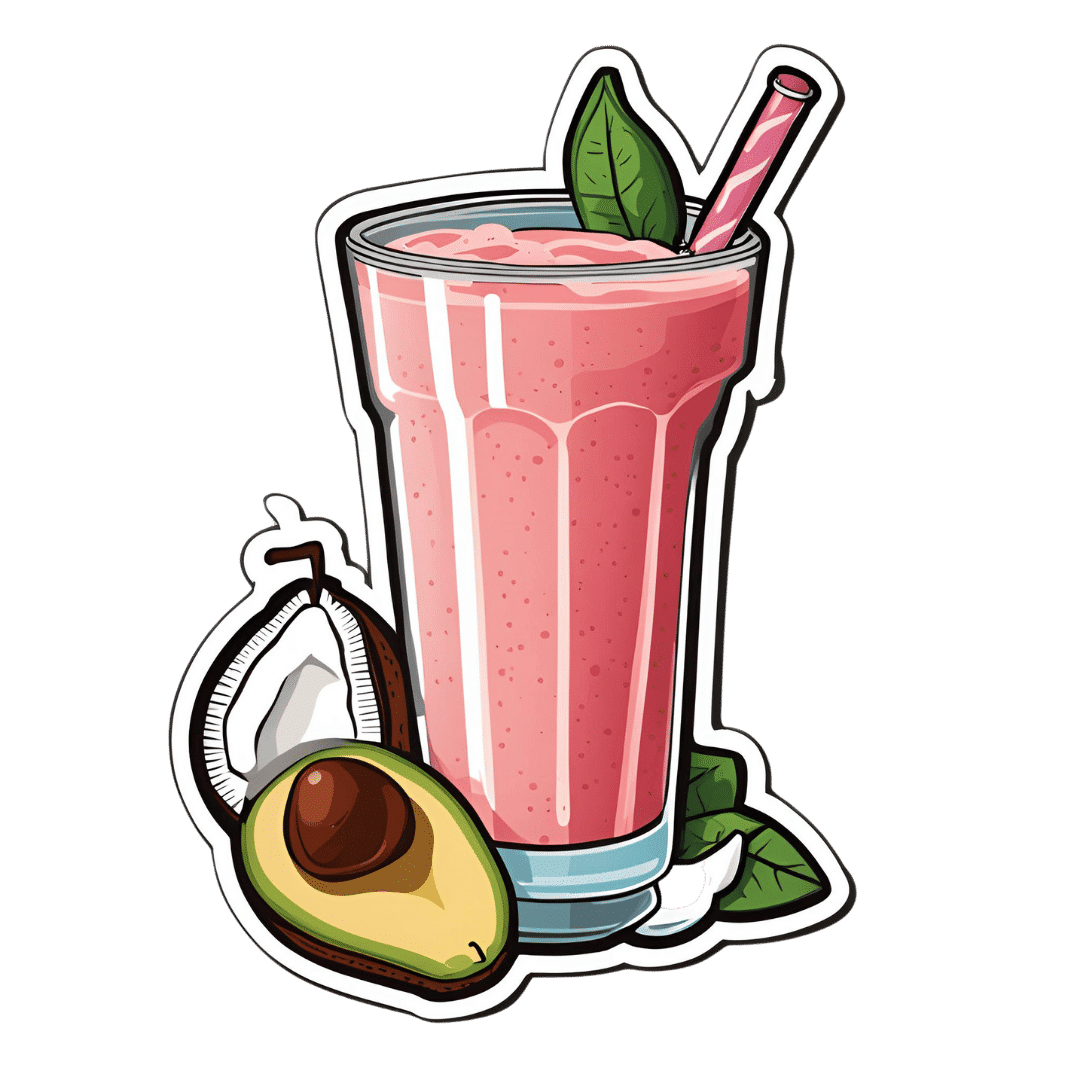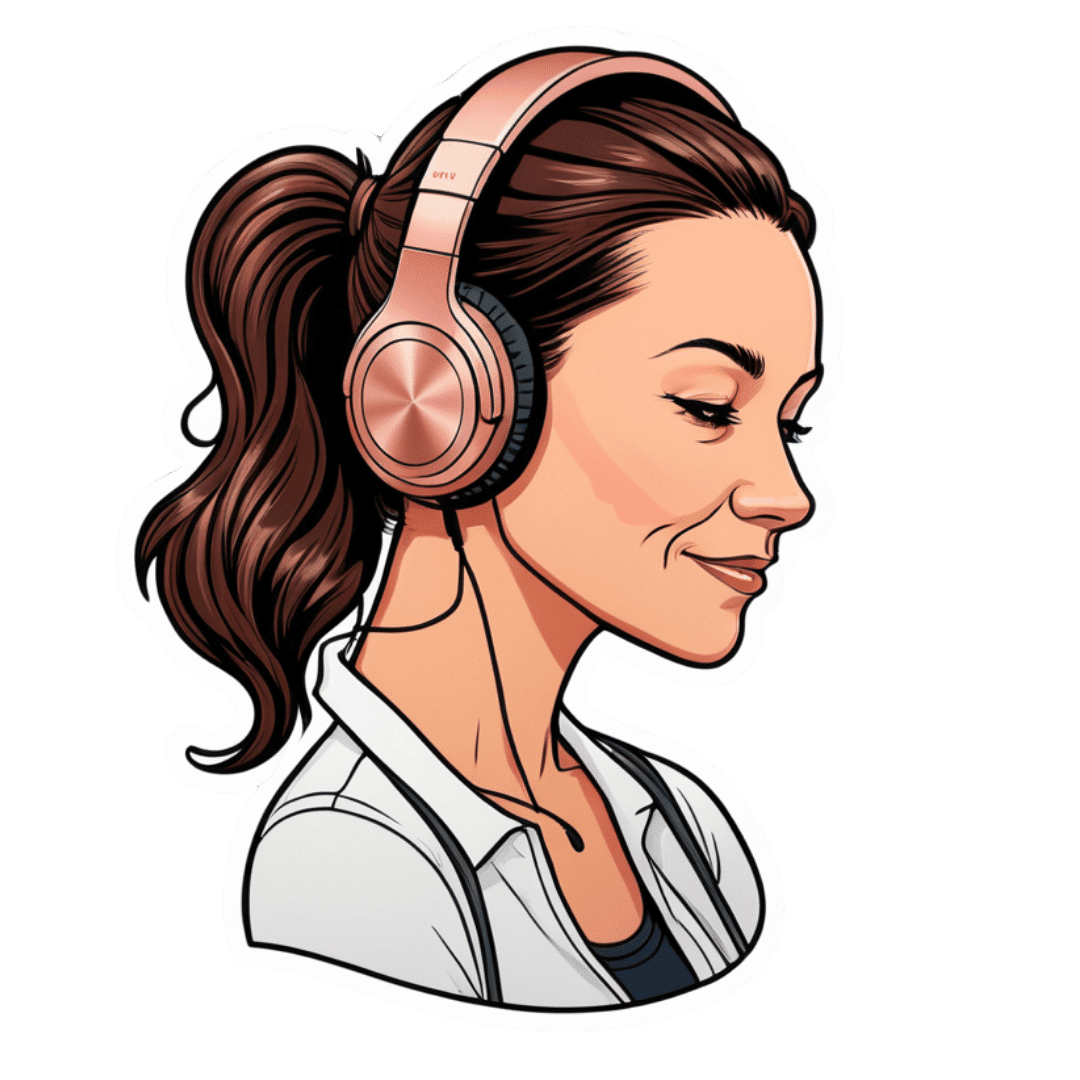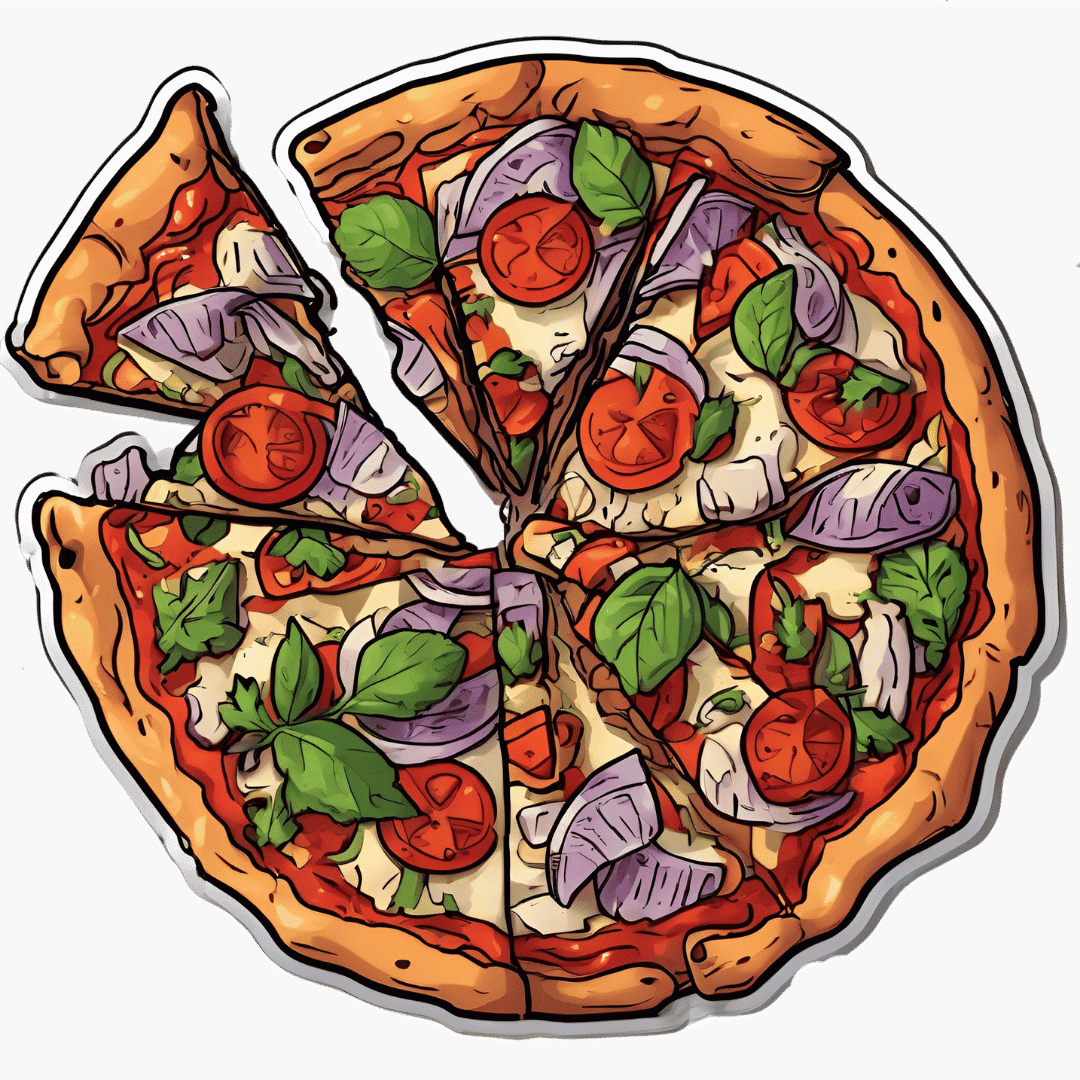
Superfood Pesto Pizza
10almonds is reader-supported. We may, at no cost to you, receive a portion of sales if you purchase a product through a link in this article.
Not only is this pizza full of foods that punch above their weight healthwise, there’s no kneading and no waiting when it comes to the base, either. Homemade pizzas made easy!
You will need
For the topping:
- 1 zucchini, sliced
- 1 red bell pepper, cut into strips
- 3 oz mushrooms, sliced
- 3 shallots, cut into quarters
- 6 sun-dried tomatoes, roughly chopped
- ½ bulb garlic (paperwork done, but cloves left intact, unless they are very large, in which case halve them)
- 1 oz pitted black olives, halved
- 1 handful arugula
- 1 tbsp extra virgin olive oil
- 2 tsp black pepper, coarse ground
- ½ tsp MSG or 1 tsp low-sodium salt
For the base:
- ½ cup chickpea flour (also called besan or gram flour)
- 2 tsp extra virgin olive oil
- ½ tsp baking powder
- ⅛ tsp MSG or ¼ tsp low-sodium salt
For the pesto sauce:
- 1 large bunch basil, chopped
- ½ avocado, pitted and peeled
- 1 oz pine nuts
- ¼ bulb garlic, crushed
- 2 tbsp nutritional yeast
- 1 tsp black pepper
- Juice of ½ lemon
Method
(we suggest you read everything at least once before doing anything)
1) Preheat the oven to 400℉ / 200℃.
2) Toss the zucchini, bell pepper, mushrooms, shallots, and garlic cloves in 1 tbsp olive oil, ensuring an even coating. Season with the black pepper and MSG/salt, and put on a baking tray lined with baking paper, to roast for about 20 minutes, until they are slightly charred.
3) When the vegetables are in the oven, make the pizza base by combining the dry ingredients in a bowl, making a pit in the middle of it, adding the olive oil and whisking it in, and then slowly (i.e., a little bit at a time) whisking in 1 cup cold water. This should take under 5 minutes.
4) Don’t panic when this doesn’t become a dough; it is supposed to be a thick batter, so that’s fine. Pour it into a 9″ pizza pan, and bake for about 15 minutes, until firm. Rotate it if necessary partway through; whether it needs this or not will depend on your oven.
5) While the pizza base is in the oven, make the pesto sauce by blending all the pesto sauce ingredients in a high-speed blender until smooth.
6) When the base and vegetables are ready (these should be finished around the same time), spread the pesto sauce on the base, scatter the arugula over it followed by the vegetables and then the olives and sun-dried tomatoes.
7) Serve, adding any garnish or other final touches that take your fancy.
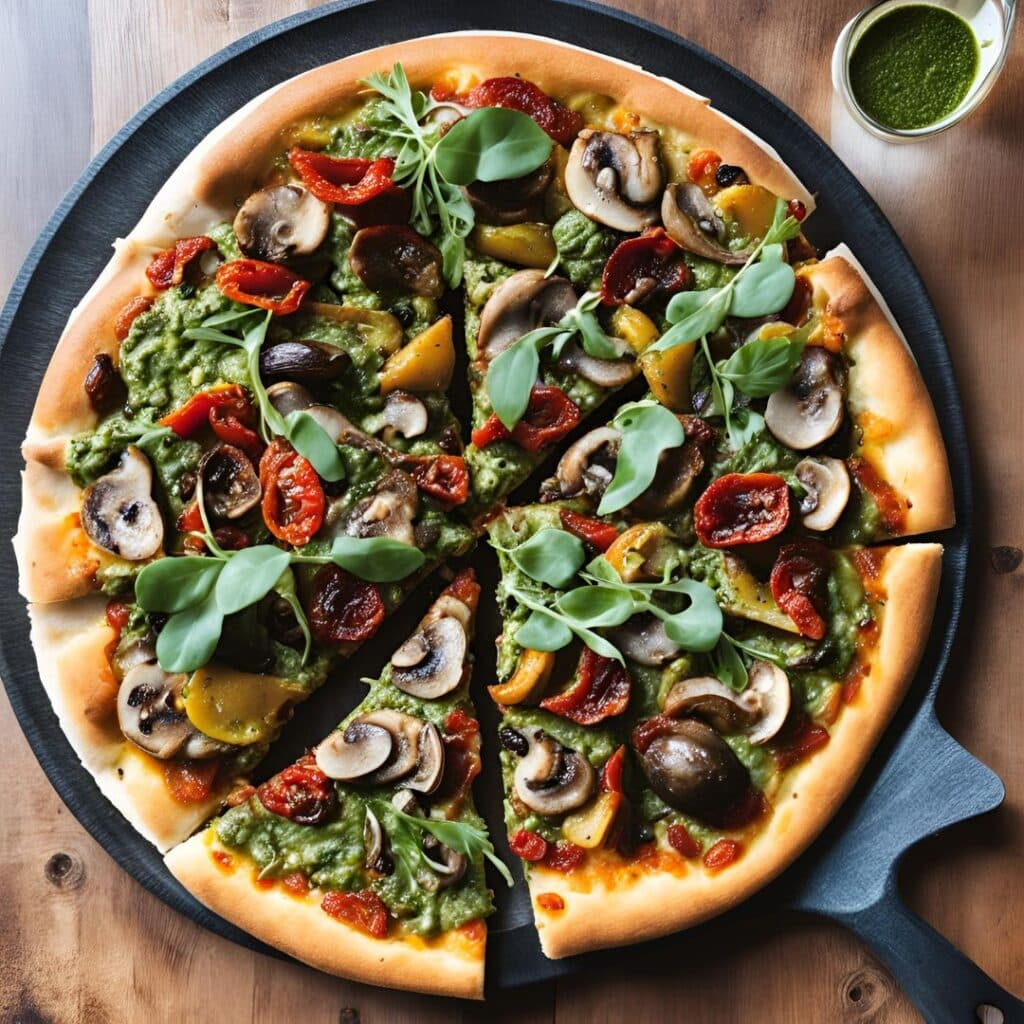
Enjoy!
Want to learn more?
For those interested in some of the science of what we have going on today:
- Which Bell Peppers To Pick? A Spectrum Of Specialties
- Ergothioneine In Mushrooms: “The Longevity Vitamin” (That’s Not A Vitamin)
- Black Olives vs Green Olives – Which is Healthier
- Lycopene’s Benefits For The Gut, Heart, Brain, & More
- Coconut vs Avocado – Which is Healthier?
- Herbs for Evidence-Based Health & Healing
- Spermidine For Longevity
Take care!
Don’t Forget…
Did you arrive here from our newsletter? Don’t forget to return to the email to continue learning!
Recommended
Learn to Age Gracefully
Join the 98k+ American women taking control of their health & aging with our 100% free (and fun!) daily emails:
-
Is Fast Food Really All That Bad?
10almonds is reader-supported. We may, at no cost to you, receive a portion of sales if you purchase a product through a link in this article.
Yes, yes it is. However, most people misunderstand the nature of its badness, which is what causes problems. The biggest problem is not the acute effects of one afternoon’s burger and fries; the biggest problem is the gradual slide into regularly eating junk food, and the long-term effects of that habit as our body changes to accommodate it (of which, people tend to focus on subcutaneous fat gain as it’s usually the most visible, but that’s really the least of our problems).
Cumulative effects
There are, of course, immediate negative effects too, and they’re not without cause for concern. Because of the composition of most junk food, it will almost by definition result in immediate blood sugar spikes, rising insulin levels, and a feeling of fatigue not long afterwards.
- Within a week of regularly consuming junk food, gut bacteria will change, resulting in moderate cravings, as well as a tendency towards depression and anxiety. Mood swings are likely, as are the gastrointestinal woes associated with any gut microbiota change.
- Within two weeks, those effects will be greater, the cravings will increase, energy levels will plummet, and likely skin issues may start to show up (our skin mostly works on a 3-week replacement cycle; some things can show up in the skin more quickly or slowly than that, though).
- Within three weeks, the rest of our blood metrics (e.g. beyond blood sugar imbalances) will start to stray from safe zones. Increased LDL, decreased HDL, and the beginnings of higher cardiovascular disease risk and diabetes risk.
- Within a month, we will likely see the onset of non-alcoholic fatty liver disease, and chronic inflammation sets in, raising the risk of a lot of other diseases, especially immune disorders and cancer.
If that seems drastic, along the lines of “eat junk food for a month and get cancer”, well, it’s an elevated risk, not a scheduled diagnosis, but the body is constantly rebuilding itself, for better or for worse, and if we sabotage its efforts by consuming a poor diet, then it will be for worse.
The good news is: this works both ways, and we can get our body back on track in fairly short order too, by enjoying a healthier diet; our body will be thrilled to start repairing itself. And of course, all these effects, good and bad, are proportional to how well or badly we eat. There’s a difference between doing a “Supersize Me” month-long 100% junk food diet, and “merely” getting a junk food breakfast each day and eating healthily later.
In short, if your diet is only moderately bad, then you will only be moderately unwell.
For more on all of this, enjoy:
Click Here If The Embedded Video Doesn’t Load Automatically!
Want to learn more?
You might also like to read:
- Fix Chronic Fatigue & Regain Your Energy, By Science
- How To Unfatty A Fatty Liver
- How to Prevent (or Reduce) Inflammation
Take care!
Share This Post
-
5 Ways To Make Your Smoothie Blood Sugar Friendly (Avoid the Spike!)
10almonds is reader-supported. We may, at no cost to you, receive a portion of sales if you purchase a product through a link in this article.
At 10almonds, we are often saying “eat whole fruit; don’t drink your calories”. Whole fruit is great for blood sugars; fruit juices and many smoothies on the other hand, not so much. Especially juices, being near-completely or perhaps even completely stripped of fiber, but even smoothies have had a lot of the fiber broken down and are still a liquid, meaning they are very quickly and easily digestible, and thus their sugars (whatever carbs are in there) can just zip straight into your veins.
However, there are ways to mitigate this…
Slow it down
The theme here is “give the digestive process something else to do”; some things are more quickly and easily digestible than others, and if it’s working on breaking down some of the slower things, it’s not waving sugars straight on through; they have to wait their turn.
To that end, recommendations include:
- Full-fat Greek yogurt which provides both protein and fat, helping to slow down the absorption of sugar. Always choose unsweetened versions to avoid added sugars, though!
- Coconut milk (canned) which is low in sugar and carbs, high in fat. This helps reduce blood sugar spikes, as she found through personal experimentation too.
- Avocado which is rich in healthy fats that help stabilize blood sugar. As a bonus, it blends well into smoothies without affecting the taste much.
- Coconut oil which contains medium-chain triglycerides (MCTs) that are quickly absorbed for energy without involving glucose, promoting fat-burning and reducing blood sugar spikes.
- Collagen powder which is a protein that helps lower blood sugar spikes while also supporting muscle growth, skin, and joints.
For more on all of these, enjoy:
Click Here If The Embedded Video Doesn’t Load Automatically!
Want to learn more?
You might also like to read:
Take care!
Share This Post
-
Intermittent Fasting, Intermittently?
10almonds is reader-supported. We may, at no cost to you, receive a portion of sales if you purchase a product through a link in this article.
It’s Q&A Day at 10almonds!
Have a question or a request? We love to hear from you!
In cases where we’ve already covered something, we might link to what we wrote before, but will always be happy to revisit any of our topics again in the future too—there’s always more to say!
As ever: if the question/request can be answered briefly, we’ll do it here in our Q&A Thursday edition. If not, we’ll make a main feature of it shortly afterwards!
So, no question/request too big or small 😎
❝Have you come across any research on alternate-day intermittent fasting—specifically switching between one day of 16:8 fasting and the next day of regular eating patterns? I’m curious if there are any benefits or drawbacks to this alternating approach, or if the benefits mainly come from consistent intermittent fasting?❞
Short and unhelpful answer: no
Longer and hopefully more helpful answer:
As you probably know, usually people going for approaches based on the above terms either
- practise 16:8 fasting (fast for 16 hours each day, eat during an 8-hour window) or
- practise alternate-day fasting (fast for 24 hours, eat whenever for 24 hours, repeat)
…which latter scored the best results in this large meta-analysis of studies:
There is also the (popular) less extreme version of alternate-day fasting, sometimes called “eat stop eat”, which is not a very helpful description because that describes almost any kind of eating/fasting, but it usually refers to “once per week, take a day off from eating”.
You can read more about each of these (and some other variants), here:
Intermittent Fasting: What’s The Truth?
What you are describing (doing 16:8 fasting on alternate days, eating whenever on the other days) is essentially: intermittent fasting, just with one 16-hour fast per 48 hours instead of per the usual 24 hours.
See also: International consensus on fasting terminology ← the section on the terms “STF & PF” covers why this gets nudged back under the regular IF umbrella
Good news: this means there is a lot of literature into the acute (i.e., occurring the same day, not long-term)* benefits of 16:8 IF, and that means that you will be getting those benefits, every second day.
You remember that meta-analysis we posted above? While it isn’t mentioned in the conclusion (which only praised complete alternate-day fasting producing the best outcomes overall), sifting through the results data discovers that time-restricted eating (which is what you are doing, by these classifications) was the only fasting method to significantly reduce fasting blood glucose levels.
(However, no significant differences were observed between any IF form and the reference (continuous energy restriction, CER, i.e. calorie-controlled) diets in fasting insulin and HbA1c levels)
*This is still good news in the long-term though, because getting those benefits every second day is better than getting those benefits on no days, and this will have a long-term impact on your healthy longevity, just like how it is better to exercise every second day than it is to exercise no days, or better to abstain from alcohol every second day than it is to abstain on no days, etc.
In short, by doing IF every second day, you are still giving your organs a break sometimes, and that’s good.
All the same, if it would be convenient and practical for you, we would encourage you to consider either the complete alternate-day fasting (which, according to a lot of data, gives the best results overall),or time-restricted eating (TRE) every day (which, according to a lot of data, gives the best fasting blood sugar levels).
You could also improve the TRE days by shifting to 20:4 (i.e., 20 hours fasting and 4 hours eating), this giving your organs a longer break on those days.
Want to learn more?
For a much more comprehensive discussion of the strengths and weaknesses of different approaches to intermitted fasting, check out:
Enjoy!
Share This Post
Related Posts
-
What Menopause Does To The Heart
10almonds is reader-supported. We may, at no cost to you, receive a portion of sales if you purchase a product through a link in this article.
World Menopause Day: Menopause & Cardiovascular Disease Risk
Today, the 18th of October, is World Menopause Day.
The theme for this year is cardiovascular disease (CVD), and if your first reaction is to wonder what that has to do with the menopause, then this is the reason why it’s being featured. Much of the menopause and its effects are shrouded in mystery; not because of a lack of science (though sometimes a bit of that too), but rather, because it is popularly considered an unimportant, semi-taboo topic.
So, let’s be the change we want to see, and try to fix that!
What does CVD have to do with the menopause?
To quote Dr. Anjana Nair:
❝The metabolic and clinical factors secondary to menopause, such as dyslipidemia, insulin resistance, fat redistribution and systemic hypertension, contribute to the accelerated risk for cardiovascular aging and disease.
Atherosclerosis appears to be the end result of the interaction between cardiovascular risk factors and their accentuation during the perimenopausal period.
The increased cardiovascular risk in menopause stems from the exaggerated effects of changing physiology on the cardiovascular system.❞
Source: Cardiovascular Changes in Menopause
See also: Menopause-associated risk of cardiovascular disease
Can we do anything about it?
Yes, we can! Here be science:
- Menopause Transition and Cardiovascular Disease Risk: Implications for Timing of Early Prevention: A Scientific Statement From the American Heart Association
- Cardiovascular risk in menopausal women and our evolving understanding of menopausal hormone therapy: risks, benefits, and current guidelines for use
This (in few words: get your hormone levels checked, and consider HRT if appropriate) is consistent with the advice from gynecologist Dr. Jen Gunter, whom we featured back in August:
What You Should Have Been Told About The Menopause Beforehand
What about lifestyle changes?
We definitely can do some good things; here’s what the science has to say:
- Mediterranean diet: yes, evidence-based
- High soy consumption: mixed evidence, unclear. So, eat it if you want, don’t if you don’t.
- Supplements e.g. vitamins and minerals: yes, evidence-based.
- Supplements e.g. herbal preparations: many may help, but watch out for adverse interactions with meds. Check with your pharmacist or doctor.
- Supplements; specifically CBD: not enough evidence yet
- Exercise: yes, evidence-based—especially low-impact high-resistance training, for bone strength, as well as regular moderate-intensity exercise and/or High-Intensity Interval Training, to guard against CVD.
For a full low-down on all of these:
Revealing the evidence-based lifestyle solutions to managing your menopause symptoms
Want to know more?
You can get the International Menopause Society’s free downloadable booklet here:
Menopause & Cardiovascular Disease: What Women Need To Know
You may also like our previous main feature:
What Does “Balance Your Hormones” Even Mean?
Take care!
Don’t Forget…
Did you arrive here from our newsletter? Don’t forget to return to the email to continue learning!
Learn to Age Gracefully
Join the 98k+ American women taking control of their health & aging with our 100% free (and fun!) daily emails:
-
How Much Does A Vegan Diet Affect Biological Aging?
10almonds is reader-supported. We may, at no cost to you, receive a portion of sales if you purchase a product through a link in this article.
Slow Your Aging, One Meal At A Time
This one’s a straightforward one today, and the ““life hack” can be summed up:
Enjoy a vegan diet to enjoy younger biological age.
First, what is biological age?
Biological age is not one number, but a collection of numbers, as per different biomarkers of aging, including:
- Visual markers of aging (e.g. wrinkles, graying hair)
- Performative markers of aging (e.g. mobility tests)
- Internal functional markers of aging (e.g. tests for cognitive decline, eyesight, hearing, etc)
- Cellular markers of aging (e.g. telomere length)
We wrote more about this here:
Age & Aging: What Can (And Can’t) We Do About It?
A vegan diet may well impact multiple of those categories of aging, but today we’re highlighting a study (hot off the press; published only a few days ago!) that looks at its effect on that last category: cellular markers of aging.
There’s an interesting paradox here, because this category is:
- the most easily ignorable; because we all feel it if our knees are giving out or our skin is losing elasticity, but who notices if telomeres’ T/S ratio changed by 0.0407? ← the researchers, that’s who, as this difference is very significant
- the most far-reaching in its impact, because cellular aging in turn has an effect on all the other markers of aging
Second, how much difference does it make, and how do we know?
The study was an eight-week interventional identical twin study. This means several things, to start with:
- Eight weeks is a rather short period of time to accumulate cellular aging, let alone for an intervention to accumulate a significant difference in cellular aging—but it did. So, just imagine what difference it might make in a year or ten!
- Doing an interventional study with identical twin pairs already controlled for a lot of factors, that are usually confounding variables in population / cohort / longitudinal / observational studies.
Factors that weren’t controlled for by default by using identical twins, were controlled for in the experiment design. For example, twin pairs were rejected if one or more twin in a given pair already had medical conditions that could affect the outcome:
❝Inclusion criteria involved participants aged ≥18, part of a willing twin pair, with BMI <40, and LDL-C <190 mg/dL. Exclusions included uncontrolled hypertension, metabolic disease, diabetes, cancer, heart/renal/liver disease, pregnancy, lactation, and medication use affecting body weight or energy.
Eligibility was determined via online screening, followed by an orientation meeting and in-person clinic visit. Randomization occurred only after completing baseline visits, dietary recalls, and questionnaires for both twins❞
~ Dr. Varun Dwaraka et al. ← there’s a lot of “et al.” to this one; the paper had 16 collaborating authors!
As to the difference it made over the course of the 8 weeks…
❝Various measures of epigenetic age acceleration (PC GrimAge, PC PhenoAge, DunedinPACE) were assessed, along with system-specific effects (Inflammation, Heart, Hormone, Liver, and Metabolic).
Distinct responses were observed, with the vegan cohort exhibiting significant decreases in overall epigenetic age acceleration, aligning with anti-aging effects of plant-based diets. Diet-specific shifts were noted in the analysis of methylation surrogates, demonstrating the influence of diet on complex trait prediction through DNA methylation markers.❞
~ Ibid.
You can read the whole paper here (it goes into a lot more detail than we have room to here, and also gives infographics, charts, numbers, the works):
Were they just eating more healthily, though?
Well, arguably yes, as the results show, but to be clear:
The omnivorous diet compared to the vegan diet in this study was also controlled; both groups were given a healthy meal plan for their respective diet. So this wasn’t a case of “any omnivorous diet vs healthy vegan diet”, but rather “healthy omnivorous diet vs healthy vegan diet”.
Again, the paper itself has the full details—a short version is that it involved a healthy meal kit delivery service, followed by ongoing dietician involvement in an equal and carefully-controlled fashion.
So, aside from that one group had an omnivorous meal plan and the other vegan, both groups received the same level of “healthy eating” support, guidance, and oversight.
But isn’t [insert your preferred animal product here] healthy?
Quite possibly! For general health, general scientific consensus is that eating at least mostly plants is best, red meat is bad, poultry is neutral in moderation, fish is good in moderation, dairy is good in moderation if fermented, eggs are good in moderation if not fried.
This study looked at the various biomarkers of aging that we listed, and not every possible aspect of health—there’s more science yet to be done, and the researchers themselves are calling for it.
It also bears mentioning that for some (relatively few, but not insignificantly few) people, extant health conditions may make a vegan diet unhealthy or otherwise untenable. Do speak with your own doctor and/or dietician if unsure.
See also: Do We Need Animal Products To Be Healthy?
We would hypothesize, by the way, that the anti-aging benefits of a vegan diet are probably proportional to abstention from animal products—meaning that even if you simply have some “vegan days”, while still consuming animal products other days, you’ll still get benefit for the days you abstained. That’s just our hypothesis though.
Take care!
Don’t Forget…
Did you arrive here from our newsletter? Don’t forget to return to the email to continue learning!
Learn to Age Gracefully
Join the 98k+ American women taking control of their health & aging with our 100% free (and fun!) daily emails:
-
Does Music Really Benefit The Brain?
10almonds is reader-supported. We may, at no cost to you, receive a portion of sales if you purchase a product through a link in this article.
It’s Q&A Day at 10almonds!
Have a question or a request? We love to hear from you!
In cases where we’ve already covered something, we might link to what we wrote before, but will always be happy to revisit any of our topics again in the future too—there’s always more to say!
As ever: if the question/request can be answered briefly, we’ll do it here in our Q&A Thursday edition. If not, we’ll make a main feature of it shortly afterwards!
So, no question/request too big or small 😎
❝Is it actually beneficial for the brain to listen to music, or is it just in line with any relaxing activity? And what kind of music is most beneficial❞
The short answer, first of all, is that it is indeed beneficial.
One reason for this without having to get very deep into it, is that a very important thing for general brain health is using it, and that means lighting up all areas of your brain.
Now, we all lead different lives and thus different parts of our brains will get relatively more resources than others depending on what we do with them, and that’s ok.
For example, if you were to scan this writer’s polyglot brain, you’d surely find overdevelopment in areas associated with language use and verbal memory, but if you were to scan a taxi-driver’s brain, then it’d be spatial reasoning and spatial memory that’s overpowered, and for a visual artist, it may be visual processing and creativity that’s enhanced. A musician’s brain? Fine motor skills, auditory processing, auditory memory.
Now, for those of us who aren’t musicians, how then can we light up areas associated with music? By listening to music, of course. It won’t give us the fine motor skills of a concert violinist, but the other areas we mentioned will get a boost.
See also: How To Engage Your Whole Brain ← this covers music too, but it’s about (as the title suggests) the whole brain, so check it out and see if there are any areas you’ve been neglecting!
There are other benefits too, though, including engaging our parasympathetic nervous system, which is good for our heart, gut, brain, and general health—especially if we sing or hum along to the music:
The Science Of Sounds ← this also covers the science (yes, science) of mantra meditation vs music
As for “and what kind of music is most beneficial”, we’d hypothesize that a variety is best, just like with food!
However, there are some considerations to bear in mind, with science to support them. For example…
About tempo:
❝EEG analysis revealed significant changes in brainwave signals across different frequency bands under different tempi.
For instance, slow tempo induced higher Theta and Alpha power in the frontal region, while fast tempo increased Beta and Gamma band power.
Moreover, fast tempo enhanced the average connectivity strength in the frontal, temporal, and occipital regions, and increased phase synchrony value (PLV) between the frontal and parietal regions.❞
Read in full: Music tempo modulates emotional states as revealed through EEG insights
And if you’re wondering about those different brainwave bands, check out:
- How to get many benefits of sleep, while awake! Non-Sleep Deep Rest: A Neurobiologist’s Take ← although it’s not in the title, this does also cover the different brain wave bands
- Alpha, beta, theta: what are brain states and brain waves? And can we control them?
Additionally, if you just want science-backed relaxation, the following 8-minute soundscape was developed by sound technicians working with a team of psychologists and neurologists.
It’s been clinically tested, and found to have a much more relaxing effect (in objective measures of lowering heart rate and lowering cortisol levels, as well as in subjective self-reports) than merely “relaxing music”.
Try it and see for yourself:
Click Here If The Embedded Video Doesn’t Load Automatically!
For much deeper dive into the effect of music on the brain, check out this book we reviewed a while back, by an accomplished musician and neuroscientist (that’s one person, who is both things):
This Is Your Brain on Music – by Dr. Daniel Levitin
Enjoy!
And now for a bonus item…
A s a bit of reader feedback prompted some interesting thoughts:
❝You erred on the which is better section. Read this carefully :Looking at minerals, grapes have more calcium, copper, iron, magnesium, phosphorus, selenium, and zinc, while grapes have more potassium and manganese. A clear win for strawberries here.❞
You’re quite right; thank you for pointing it out, and kindly pardon the typo, which has now been corrected!
The reason for the mistake was because when I (writer responsible for it here, hi) was writing this, I had the information for both fruits in front of me, but the information for grapes was on the right in my field of vision, so I errantly put it on the right on the page, too, while also accidentally crediting strawberries’ minerals to grapes, since strawberries’ data was on the left in my field a vision.
The reason for explaining this: it’s a quirky, very human way to err, in an era when a lot of web content is AI-generated with very different kinds of mistakes (usually because AI is very bad at checking sources, so will confidently state something as true despite the fact that the source was The Onion, or Clickhole, or someone’s facetiously joking answer on Quora, for example).
All in all, while we try to not make typos, we’d rather such human errors than doing like an AI and confidently telling you that Amanita phalloides mushrooms are a rich source of magnesium, and also delicious (they are, reportedly, but they are also the most deadly mushroom on the face of the Earth, also known as the Death Cap mushroom).
In any case, here’s the corrected version of the grapes vs strawberries showdown:
Grapes vs Strawberries – Which is Healthier?
Enjoy!
Don’t Forget…
Did you arrive here from our newsletter? Don’t forget to return to the email to continue learning!
Learn to Age Gracefully
Join the 98k+ American women taking control of their health & aging with our 100% free (and fun!) daily emails:

